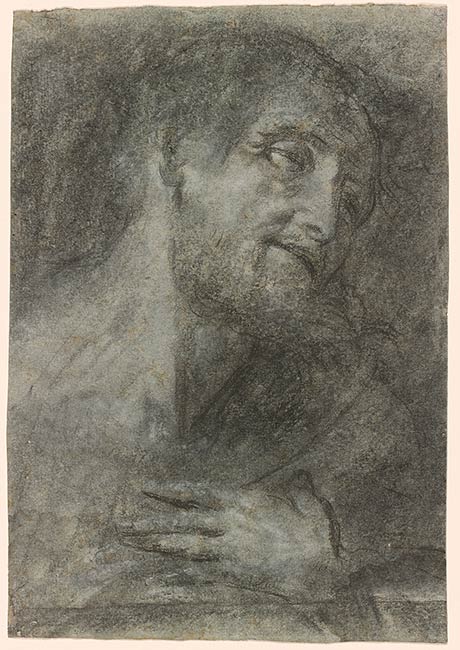
Savoldo remains somewhat difficult to define as an artist. We do not know with certainty the date or place of his birth or death. He described himself as Brescian, and he is known to have worked in Parma and Florence early in his career, but by 1520 (and perhaps well before then) he had settled in Venice, where he remained until he was last documented there as “very old” in 1548. His output seems to have been small, and only around forty paintings and fifteen drawings are attributed to him today. The dating of his works and the trajectory of his career remain matters of speculation.
Modern scholarship’s strong emphasis on the Lombard aspects of Savoldo’s art reflects the overwhelming influence of Roberto Longhi, who was concerned with asserting Savoldo’s role as a Lombard model for Caravaggio.1 Savoldo may indeed have received his training in Lombardy, for a number of his paintings seem to take up themes by Leonardo da Vinci and his followers. Yet the mood of Savoldo’s compositions could be related to Giorgione as much as to Leonardo, and the bright color schemes of Savoldo’s paintings relate to Venetian rather than Lombard art. Turning from painting to drawing, it might be observed that sheets like the present work, with the figure emerging from a haze of soft black chalk, bear some relationship to Leonardesque drawings. Despite this, the influence of Venetian drawing, particularly of Titian’s black-and-white drawings on blue paper, is unmistakable.2 Indeed, the Venetian qualities of the present work are so strong that it has at times been attributed to Paris Bordone,3 although the attribution to Savoldo is now generally and correctly accepted.4 The half-closed eyes with prominent lids, the tilt of the head, and the very sentiment of the figure are found throughout Savoldo’s work, and the technique of the drawing compares closely to other sheets by the artist, such as the Head of a Bearded Man at the Getty5 and the Head of a Woman with Eyes Closed at the Uffizi (inv. 12806). Virtually all of the drawings attributed to Savoldo are expressive head studies of this type. While the Morgan drawing seems as though it could be a preparatory study for a figure of Christ, or a saint, or even the donor in an altarpiece, it has never been connected to any known painting by the artist.
—JJM
Footnotes:
- For a brief summary of Savoldo’s critical fortunes and the debate over his Lombard versus Venetian qualities, see, for example, Nova 1990.
- Rearick, in Florence 1976, 78, expresses the same opinion of Savoldo’s drawings.
- Attributed to Savoldo when acquired by Janos Scholz, the drawing was reattributed to Bordone in Bloomington and elsewhere 1958, no. 42, although Creighton Gilbert, the editor of that exhibition catalogue, later stressed his support for the traditional attribution to Savoldo. As Linda Wolk-Simon notes in New York and Chicago 1994, 54, a number of drawings by Savoldo, including the Head and Shoulders of a Bearded Man at the Morgan (inv. 1977.61; see Brescia and Frankfurt 1990, no. II.11) as well as the Head of a Bearded Man in the Royal Collection, Windsor (see Brescia and Frankfurt 1990, no. II.10), have been at times attributed to Bordone and further attest to the Venetian qualities of Savoldo’s draftsmanship. Bordone’s Head of a Bearded Man with Eyes Closed at the Morgan (inv. 1981.90; see Fossaluzza and Manzato 1987, 50–51) demonstrates the similarity of his drawings but is also representative of Bordone’s more restrained use of chalk.
- See Wolk-Simon in New York 2004, 142–43, for further discussion of the attribution.
- J. Paul Getty Museum, Los Angeles, inv. 83.GB.17.
Watermark: none.
An alternate attribution to Paris Bordone has also been suggested by several scholars.
Inscribed on verso, at upper left, in red chalk, "X/A".
Bordone, Paris, 1500-1571, Possible attribution.
Geiger, Benno, 1882-1965, former owner.
Cassini, Stefano, former owner.
Scholz, János, former owner.
Rhoda Eitel-Porter and and John Marciari, Italian Renaissance Drawings at the Morgan Library & Museum, New York, 2019, no. 60.
Selected references: Oakland and elsewhere 1956, no. 81; Venice 1957, no. 12; Bloomington and elsewhere 1958, no. 42; Oakland and San Francisco 1959, no. 10; Hagerstown 1960-61, no. 9; Staten Island 1961, no. 9; Cologne 1963-64, no. 144; Milwaukee 1964, no. 9; 78; Norton 1971, no. 22; Washington and New York 1973-74, no. 79; Scholz 1976, no. 31; Notre Dame 1980, no. 146; Cleveland 1981, no. 122; Brescia and Frankfurt 1990, no. 11.10; Nova 1990, 431-34; Griswold 1994, 24-28; New York and Chicago 1994, no. 48; Tanzi 1994, 159-64, no. 9; New York 2004, no. 50.
Muraro, Michelangelo. Venetian Drawings from the Collection János Scholz. Venice : N. Pozza, 1957, no. 12, repr.
Oberhuber, Konrad, and Dean Walker. Sixteenth Century Italian Drawings From the Collection of János Scholz. Washington, D.C. : National Gallery of Art ; New York : Pierpont Morgan Library, 1973, no. 79, repr.
Ryskamp, Charles, ed. Twentieth Report to the Fellows of the Pierpont Morgan Library, 1981-1983. New York : Pierpont Morgan Library, 1984, p. 298.
